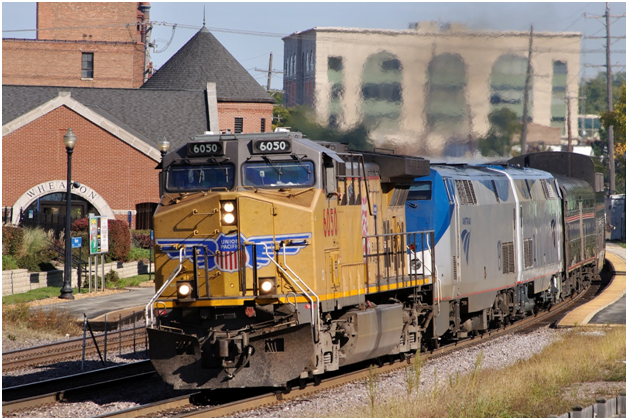
In a press release dated today, the Federal Railroad Administration announced the intent to regulate crew sizes of both freight and passenger trains. In October of 2011, a Union Pacific freight locomotive assisted Amtrak passenger locomotives pulling train #5, the “California Zephyr” via a special detour routing through Wheaton, Illinois in suburban Chicago. (photo copyright 2011 by Paul Burgess, all rights reserved)
Fallout from the Lac Megantic, Quebec train derailment in July of 2013 continues for the rail industry in general with the issuance today of a press release by the Federal Railroad Administration (FRA) which announces FRA’s intent to issue a proposed rulemaking (or, NPRM) which will for the first time mandate the size of train crews operating almost every type of train.
The press release specifically references the Lac Megantic accident as the impetus for this NPRM, which will require railroads to assign at least two crewmembers to crude oil trains and will, in the words of the press release, “(establish) minimum crew size standards for most main line freight and passenger rail operations.” The press release does not however delve into the specific numbers associated with this statement (note that most current main line trains do operate with two crewmembers; however, this is common practice, not law, nor is it universal). FRA does note that “appropriate” exceptions may be anticipated. It goes on to announce that FRA will issue an additional proposed rulemaking on train securement.
In the Lac Megantic accident, an unattended train loaded with crude oil had an apparent failure of securement which was allegedly contributory to its resulting derailment.The press release further notes that FRA is recommending additional measures regarding the identification, classification, operational control, and handling of hazardous materials shipments to the Pipeline and Hazardous Materials Safety Administration (PHMSA). PHMSA retains authority for such rulemakings, however in this case since FRA is essentially asking PHMSA to take action on these subjects; it is more rather than less likely to occur. Specifics include requested action regarding amending the definition of “residue” and “key train” (a “key train” is presently defined in the industry as a train actively carrying certain types or quantities of hazardous materials, which carriage thus assigns specific additional rules and restrictions to its operation) and clarifying the jurisdiction of the agency over the loading, unloading, and storage of hazmat before and during transportation. The press release expounds to a certain degree on all these items, but full details will likely have to wait until the actual NPRM is released in the Federal Register.
Here is a link to the press release: http://www.fra.dot.gov/eLib/Details/L04999
All of these measures follow the recommendations of three separate Railroad Safety Advisory Committee working groups which were established by FRA to in one way or another research and develop responses to the various issues which became associated as contributory to or resulting from the Lac Megantic accident. As noted in my previous blog posts in reference to this subject, this accident, involving disastrous loss of life and property and massive environmental damage to an entire community, has apparently become a seminal event in the rail transportation of hazardous materials, and the regulatory measures that have already resulted and what further measures may result, can be laid directly at its door. Much like Valu Jet Flight 592’s crash in 1996 due to a hazmat issue, Lac Megantic is an industry game changer.
Labelmaster is a full service provider of goods and services for the Hazardous Materials and Dangerous Goods professional, shippers, transport operators, and EH&S providers. See our full line of solutions at www.labelmaster.com.

